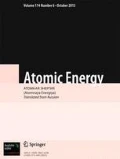The results of testing the models implemented in the OXID module of the thermohydraulic code HYDRA-IBRAE/LM, used to calculate an oxide film on a steel surface, transport of dissolved and disperse products, and coagulation of polydisperse solid particles in lead coolant flow, are presented. The module was developed for modeling the formation of an oxide film on the surface of the channels in a reactor facility with heavy liquid-metal coolant and transport of dissolved and disperse products of corrosion and oxidation in the loop.
Similar content being viewed by others
References
B. F. Gromov and P. N. Orlov, Liquid Metal Systems, Plenum, New York (1985).
V. V. Alekseev, E. V. Varseev, E. A. Orlova, et al., “Computational estimates of the mass transfer of corrosion products in the first loop of a nuclear power facility with lead coolant,” in: Heavy Liquid Metal Coolants in Nuclear Technologies, GNTS RF – FEI, Obninsk (2014), Vol. 2, pp. 329–343.
V. M. Alinchenkov, A. M. Anfimov, D. A. Afremov, et al., “Basic positions, current state of development, and prospects for further development of the next-generation thermohydraulic computational code HYDRA-IBRAE/LM for modeling reactor facilities operating on fast neutrons,” Teplotekhnika, No. 2, 54–64 (2016).
V. V. Alekseev, E. A. Orlova, F. A. Kozlov, and I. Yu. Torbenkova, Modeling of Mass Transfer and Corrosion of Steels in Nuclear Power Facilities with Lead Coolant. Part 1, FEI Preprint No. 3128 (2008).
E. V. Varseev and V. V. Alekseev, “Calculation of mass transfer in loops with liquid-metal coolants,” in: Fast Reactors, NIKIET, Moscow (2013), pp. 459–469.
K. Mikityuk, “Analytical model of the oxide layer build-up in complex lead-cooled systems,” Nucl. Eng. Design, 240, 3632–3637 (2010).
J. Zhang, N. Li, and Y. Chen, “Dynamics of high temperature oxidation accompanied by scale removal and implications for technological applications,” J. Nucl. Mater., 342, 1–7 (2005).
J. Zhang, “Models of liquid metal corrosion,” J. Nucl. Mater., 404, 82–96 (2010).
V. Ulyanov, V. Gulevsky, A. Storozhenko, and Y. Teplyakov, “Control of oxidizing potential of Pb and Pb–Bi coolants,” Orient. J. Chem., 31, 4–10 (2015).
P. L. Kirillov (ed.), Handbook of Thermohydraulic Calculations in Nuclear Power, Vol. 1, Thermohydraulic Processes in Nuclear Power Facilities, IzdAt, Moscow (2010).
M. Machur, K. Sridharan, and N. Li, “Time dependence of corrosion in steels for use in lead-alloy cooled reactors,” J. Nucl. Mater., 371 134–144 (2007).
J. Zhang and N. Li, “Oxidation mechanism of steels in liquid-lead alloys,” Oxidat. Met., 63, 353–381 (2010).
G. Samsonov (ed.), The Oxide Handbook, Plenum, New York (1973).
J. Castle and P. Surman, “The self-diffusion of oxygen in magnetite. Techniques for sampling and isotopic analysis of micro quantities of water,” J. Chem. Phys., 71, No. 13, 4255–4259 (1967).
T. Furukawa, G. Muller, and G. Shumacher. “Effect of oxygen concentration and temperature on compatibility of ODS steel with liquid stagnant Pb45Bi55,” J. Nucl. Mater., 335, 189–193 (2004).
V. M. Goloviznin and S. A. Karabasov, “Nonlinear correction of the kabare scheme,” Mat. Modelir., 10, No. 12, 107–123 (1998).
V. M. Goloviznin, M. A. Zaitsev, S. A. Karabasov, and I. A. Korotkin, New Algorithms of Computational Hydrodynamics for Multi Processor Computing Complexes, Izd. MGU, Moscow (2013).
J. Seinfeld and S. Pandis, Atmospheric Chemistry and Physics, J. Wiley, New York (1998).
A. A. Sorokin, “Modeling of coagulation of fission-product aerosols,” At. Energ., 118, No. 4, 228–232 (2015).
Author information
Authors and Affiliations
Additional information
Translated from Atomnaya Énergiya, Vol. 122, No. 3, pp. 145–149, March, 2017.
Rights and permissions
About this article
Cite this article
Usov, E.V., Sorokin, A.A., Chukhno, V.I. et al. Modeling of Oxide Layer Formation and Corrosion Products Coagulation and Transport in Lead Coolant Using the OXID Module of the HYDRA-IBRAE/LM Code. At Energy 122, 172–177 (2017). https://doi.org/10.1007/s10512-017-0252-x
Received:
Published:
Issue Date:
DOI: https://doi.org/10.1007/s10512-017-0252-x



